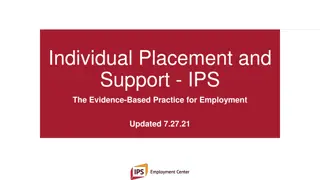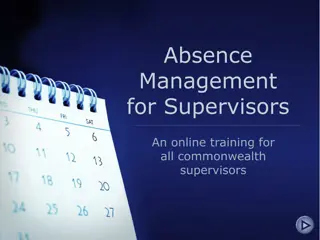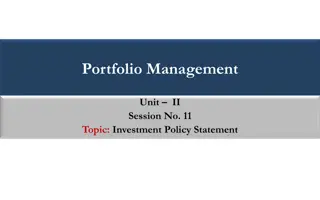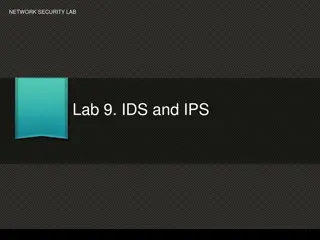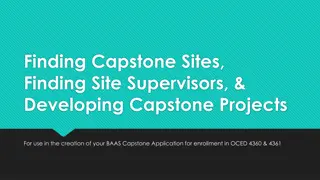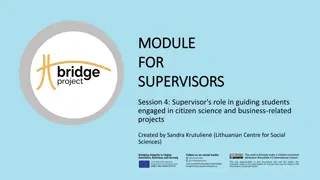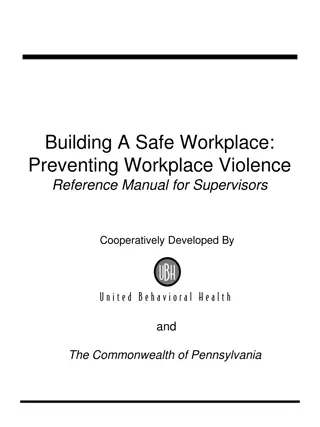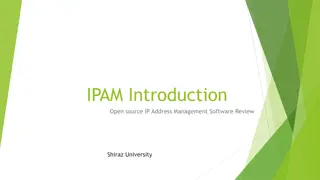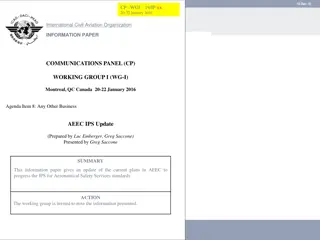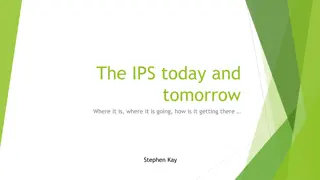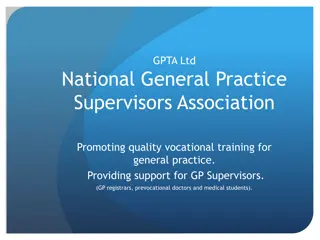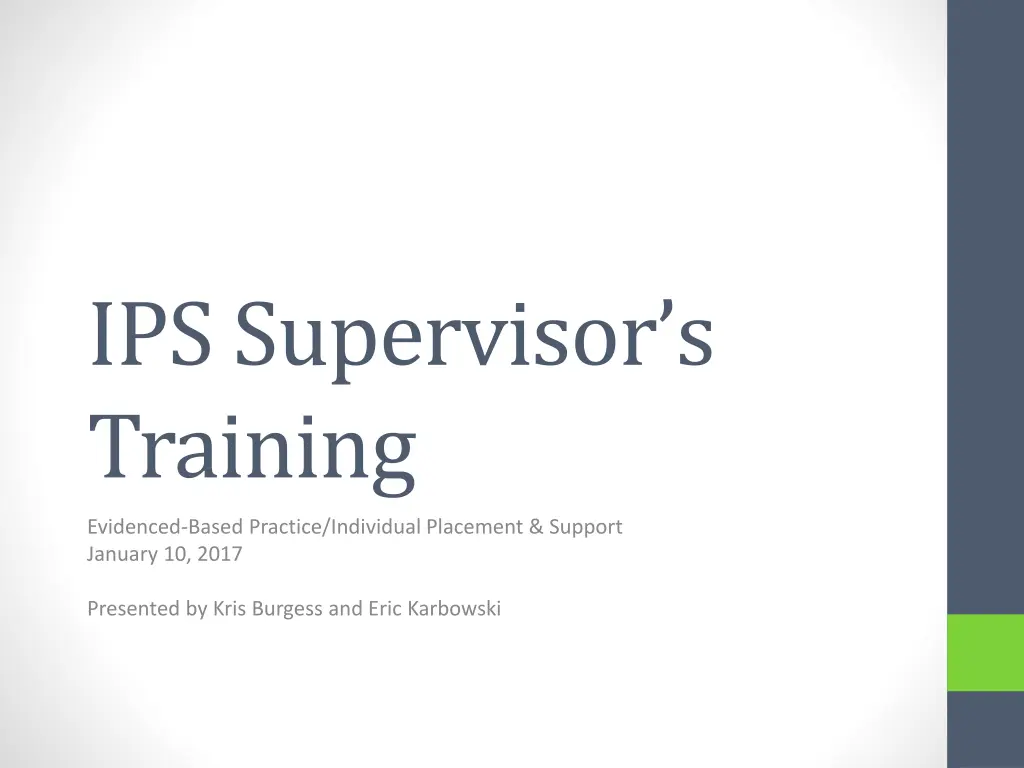
Supervisors Training on Evidenced-Based Practice for IPS
Explore the comprehensive training on Individual Placement and Support (IPS) model by Burgess and Karbowski. Learn about fidelity scores, training new specialists, effective documentation, preparing for reviews, and more to enhance IPS implementation.
Download Presentation

Please find below an Image/Link to download the presentation.
The content on the website is provided AS IS for your information and personal use only. It may not be sold, licensed, or shared on other websites without obtaining consent from the author. If you encounter any issues during the download, it is possible that the publisher has removed the file from their server.
You are allowed to download the files provided on this website for personal or commercial use, subject to the condition that they are used lawfully. All files are the property of their respective owners.
The content on the website is provided AS IS for your information and personal use only. It may not be sold, licensed, or shared on other websites without obtaining consent from the author.
E N D
Presentation Transcript
IPS Supervisors Training Evidenced-Based Practice/Individual Placement & Support January 10, 2017 Presented by Kris Burgess and Eric Karbowski
What We Have Planned 1. IPS The Model : No matter where we provide services, the model is the model. Can it look different in different places? 2. What does the Fidelity Score tell us? 3. Training New Employment Specialists 4. Documenting IPS services effectively 5. Before and After the Fidelity Review Preparing for the review and what a Plan for Improvement should include 6. Let s talk Are there areas of struggle 7. Follow along supports moving people through services 8. Integration more than shared space and meeting attendance What else do you need?
IPS The Model Quick update New IPS website www.ipsworks.org No matter where we provide services, the model is the model. Can it look different in different places? 125 point scale https://www.ipsworks.org/wp- content/uploads/2014/04/IPS-Fidelity-Scale-Eng1.pdf New reporting tool Are the Fidelity Reports helpful? Calculations (how calculations/percentages are generated) Revisiting the model Living by the model is not teaching to the test Self Reflection
IPS The Model -Continued Internal Fidelity Review Self Critiquing work Developing a plan of action Recognize and support/share growth over time
What Does The Fidelity Score Tell Us? Goal of Fidelity Reviews/Reviewers Review vs. Audit Consultation calls following a fidelity review While the reviewers are aware that financial incentives are being offered based on scores, the reviewers are not a part of that the reviews occur independent of that incentive system and occur with much consensus, collaboration, on-going discussion and learning among team members. Score Frequency of Review Allowance from BHDDA 74-99 Fair Fidelity Annual Review $400 per fiscal year 100-114 Good Fidelity Every other year $800 per fiscal year 115-125 Exemplary Fidelity Every third year $1500 per fiscal year
Training New Employment Specialist Invest the time upfront in developing staff. Develop/organize training schedule: Westat Orientation Checklist CMHCM sample training schedule Teach all employment specialist to be fidelity reviewers. Set expectations high from the beginning. Live the model and model the model. Recognize and celebrate success.
Documenting IPS Services Effectively Internal Chart reviews Chart review form Handout Peer reviewed charts Does your program/agency have expectations for documentation? Do the employment staff know/understand those expectations? The golden thread for IPS service documentation: samples
Preparing For The External Fidelity Review Sample agenda Handout What reviewers will need to see Agendas, meeting minutes, supervisory notes, QI data, case lists, job development logs, list of jobs, etc. Helpful hints It s more beneficial to participate in a real meeting. Try to schedule a review on the days those meetings naturally occur. It s really helpful to reviewers to meet with the Team early in the review the earlier the better. The Review Team is used to being flexible, splitting up the work, working through lunches, etc. Use us while we re on site!
Developing A Plan for Improvement Post Review The Importance of the Consultation Call Why/Purpose Examples
Please Be Aware Team members and shadows Maximizing the opportunity of having a review While the Review Team is on site EMR differences Multiple points of verification Opportunity for the site to get clarification following the review Consultation Call Opportunity for the site to provide feedback on the review process following the review Fidelity reviewers continue to grow and learn new things in the model
Lets talk Are There Areas of Struggle What are your program goals? Are you developing short term and long term goals? Does everyone on the team know what the program goals are? Who developed the goals? Does the team agree with/is there buy into the goals? Are there individual goals for each Employment Specialist? Does the ES know his/her goal(s)? Who developed the goal(s)? Does the ES buy into the goal(s)?
Follow Along Supports What do follow along supports look like in your program? Is there a plan for follow along supports? Can anyone take over the supports if the ES left? How are you documenting follow along supports? MRS expectations regarding follow along supports
Integration It s more than shared space and meeting attendance. What Fidelity tells us about integration: 1) Employment Specialists attend weekly treatment team meetings. 2) Employment specialists actively participate in weekly mental health treatment team meetings (not replaced by administrative meetings) that discuss individual clients and their employment goals with shared decision-making. 3) Employment specialist s office is in close proximity to (or shared with) their mental health treatment team members. 4) Documentation of mental health treatment and employment services is integrated in a single client chart. 5) Employment specialists help the team think about employment for people who haven t yet been referred to supported employment services. Continuous improvement








